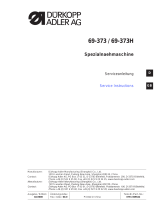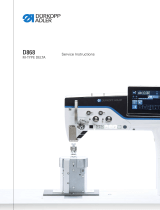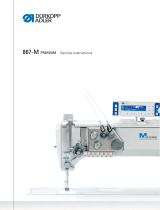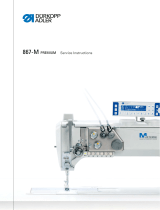Page is loading ...

367
Spezialnähmaschine
Serviceanleitung
Service Instructions
Instructions de service
Instrucciones de servicio
Instruções de serviço
Istruzioni per il servizio
Postfach 17 03 51, D-33703 Bielefeld • Potsdamer Strasse 190, D-33719 Bielefeld
Telefon +49 (0) 5 21/ 9 25-00 • Telefax +49 (0) 5 21/ 9 25 24 35 • www.duerkopp-adler.com
Ausg./Edition: 07/2006 Printed in Federal Republic of Germany Teile-/Part-No.: 0791 367641
D
GB
F
E
P
I


General safety instructions
The non-observance of the following safety instructions can cause
bodily injuries or damages to the machine.
1. The machine must only be commissioned in full knowledge of the
instruction book and operated by persons with appropriate
training.
2. Before putting into service also read the safety rules and
instructions of the motor supplier.
3. The machine must be used only for the purpose intended. Use of
the machine without the safety devices is not permitted. Observe
all the relevant safety regulations.
4. When gauge parts are exchanged (e.g. needle, presser foot,
needle plate, feed dog and bobbin) when threading, when the
workplace is left, and during service work, the machine must be
disconnected from the mains by switching off the master switch or
disconnecting the mains plug.
5. Daily servicing work must be carried out only by appropriately
trained persons.
6. Repairs, conversion and special maintenance work must only be
carried out by technicians or persons with appropriate training.
7. For service or repair work on pneumatic systems, disconnect the
machine from the compressed air supply system (max. 7-10 bar).
Before disconnecting, reduce the pressure of the maintenance
unit.
Exceptions to this are only adjustments and functions checks
made by appropriately trained technicians.
8. Work on the electrical equipment must be carried out only by
electricians or appropriately trained persons.
9. Work on parts and systems under electric current is not permitted,
except as specified in regulations DIN VDE 0105.
10. Conversion or changes to the machine must be authorized by us
and made only in adherence to all safety regulations.
11. For repairs, only replacement parts approved by us must be used.
12. Commissioning of the sewing head is prohibited until such time
as the entire sewing unit is found to comply with EC directives.


Index Page:
Service instructions class 367
1. General notes ............................................... 3
1.1 Gauges.................................................... 3
1.2 Descriptionofthelockingpositions................................... 4
2. Sewing machine.............................................. 5
2.1 Positionofthearmshaftcrankonthearmshaft........................... 5
2.2 Upper and lower toothed belt wheel/ Toothed belt .......................... 6
2.2.1 Position of the upper toothed belt wheel ................................ 6
2.2.2 Position of the lower toothed belt wheel ................................ 7
2.2.3 Change the toothed belt.......................................... 8
2.3 Bottom feed and stitch regulator gear ................................. 9
2.3.1 Basic adjustment of stitch adjustment (subclass 367-170115; -170315 and
subclass 367-180115; -180315) ..................................... 9
2.3.2 Adjust the 2nd stitch length (subclass 367-170315 and 367-180315) .............. 10
2.3.3 Stitch regulator gear ............................................ 11
2.3.4 Lifting motion of the feed-dog ...................................... 13
2.3.5 Feeding motion of the feed-dog ..................................... 14
2.3.6 Feed-dog height .............................................. 15
2.4 Needle bar linkage ............................................. 16
2.4.1 Alignment of the needle bar linkage................................... 16
2.4.2 Needle penetration in the feed-dog ................................... 18
2.5 Hook, looping stroke and needle bar height .............................. 19
2.5.1 Looping stroke, distance between hook tip and needle ....................... 19
2.5.2 Needle bar height ............................................. 21
2.6 Bobbin case holder ............................................ 22
2.7 Feeding foot and presser foot ...................................... 23
2.7.1 Stroke of feeding foot and presser foot ................................. 23
2.7.2 Lifting motion of the feeding foot .................................... 24
2.7.3 Sewingfootpressure ........................................... 25
2.8 Stitch length limitation ........................................... 26
2.8.1 Stitch length limitation in case of subclass 367-170115; -170315 and
subclass 367-180115; -180315 ..................................... 26
2.8.2 Stitch length limitation in case of subclass 367-170010 and 367-180010 ............ 27
2.8.3 Equal stitch lengths in case of subclass 367-170115; -170315 and subclass 367-180115; -180315 28
2.9 Settingtheshort-trimming ........................................ 29
2.10 Sewingfootliftandthreadtensionlift ................................. 31
2.10.1 Mechanical sewing foot lift ........................................ 31
2.10.2 Heightoftheliftedsewingfeetandliftlimitation........................... 32
2.10.3 Thread tension lift (subclass 367-170010 and 367-180010) .................... 33
2.11 Thread-guiding parts............................................ 34
2.11.1 Thread regulator .............................................. 34
2.11.2 Threadcontrollerspring.......................................... 35
2.12 Bobbin winder................................................ 36
GB

Index Page:
2.13 Threadtrimmer............................................... 38
2.13.1 Positionofthecontrolcam........................................ 38
2.13.2 Position of the hook knife ......................................... 39
2.13.3 Armature of the thread trimmer magnet ................................ 40
2.13.4 Cuttingpressure.............................................. 41
2.14 Potentiometerinthearm......................................... 42
2.14.1 Basic adjustment without control panel................................. 42
2.14.2 Basic adjustment with control panel V810 or V820.......................... 43
2.14.3 Checkadjustmentofpotentiometer................................... 44
2.15 Oillubrication................................................ 45
2.15.1 Hooklubrication .............................................. 46
2.16 Maintenance ................................................ 47

GB
1. General notes
The service instructions on hand describe the adjustment of the
special sewing machine 367.
ATTENTION !
The operations described in the service instructions must only be
executed by qualified staff or correspondingly instructed persons
respectively!
Caution: Danger of injury !
In case of repair, alteration or maintenance work switch off main switch
and disconnect the machine from the pneumatic supply system.
Carry out adjusting operations and functional tests of the running
machine only under observation of all safety measures and with utmost
caution.
The instruction manual on hand describes the adjustment of the
sewing machine in an appropriate sequence. Please observe in this
connection that various setting positions are interdependent. Therefore
it is absolutely necessary to do the adjustment following the described
order.
For all setting operations of parts involved in the stitch formation a new
needle without damage has to be inserted.
Machine covers having to be screwed off and on again for checking
and adjusting operations are not mentioned in the text.
Hint:
Some of the shafts of the special sewing machine 367 are provided
with flat spots. This facilitates the adjustment considerably.
In case of all adjustments on flat spots the first screw in rotation
direction is put on such a flat spot.
1.1 Gauges
The locking peg 1 required for adjusting the machine belongs to the
standard accessories. It is located at the bottom side of the oil pan.
–Tilt machine head to the back.
–Take the locking peg 1 out of the fixture.
–Tilt machine head back.
3
1

1.2 Description of the locking positions
With the locking peg 1 and the arresting grooves 2 and 3 in the arm
shaft crank 4 the sewing machine can be arrested in two adjusting
positions.
Position I = Locking peg Ø 5 mm for large groove
Position II = Locking peg Ø 3 mm for small groove
Adjustments to be done in these two positions:
Position I Looping stroke, needle bar height
Position II Standstill of the feed-dog when moving the
stitch regulator linkage (zero position of gear)
4
3
2
4
1

2. Sewing machine
2.1 Position of the arm shaft crank on the arm shaft
Caution: Danger of injury !
Switch off main switch.
Check and set the position of the arm shaft crank only when the
machine is switched off.
Standard checking
The arm shaft crank 1 is fastened on the arm shaft 4 with the three
screws 2. The screws must sit on the flat spot 3.
Correction
–Loosen screws 2 at the arm shaft crank.
–Twist arm shaft crank 1 on the shaft in such a way that
the screws 2 sit on the flat spot 3.
–Push arm shaft crank 1 axially to the right as far as it will go.
–Tighten screws 2.
5
GB
21
1
2
3
4

2.2 Upper and lower toothed belt wheel/ Toothed belt
2.2.1 Position of the upper toothed belt wheel
Caution: Danger of injury !
Switch off main switch.
Check and set the position of the upper toothed belt wheel only when
the machine is switched off.
Standard checking
The toothed belt wheel 2 is fastened on the arm shaft 4 with two
screws. The screws must sit on the flat spot 1.
The distance between the toothed wheel 2 and the bobbin winder
wheel 3 must amount to 0.8 mm when the bobbin winder is switched
off.
–Check distance between toothed belt wheel 2 and bobbin winder
wheel 3 by means of a feeler gauge.
Correction
–Loosen core pins 5 in the toothed belt wheel 2.
–Turn toothed belt wheel 2 until the screws sit on the flat spot 1 of
the arm shaft 4.
–Set lateral distance of 0.8 mm between toothed belt wheel 2 and
bobbin winder wheel 3 by a feeler gauge.
–Tighten core pins 5 in the toothed belt wheel 2.
6
4352
1

2.2.2 Position of the lower toothed belt wheel
Caution: Danger of injury !
Switch off main switch.
Check and adjust position of the lower toothed belt wheel only when
the sewing machine is switched off.
Standard checking
The lower toothed belt wheel 1 must abut on the bearing 3.
The core pins 5 in the toothed belt wheel 1 must sit on the flat spot of
the lower shaft 4.
–Check whether the toothed belt wheel abuts on the bearing.
Correction
–Pull off toothed belt from the lower toothed belt wheel 1.
–Loosen core pins in the toothed belt wheel.
–Turn toothed belt wheel 1 until the screws sit on the flat spot of the
lower shaft 4.
–Hold lower shaft 4 and push toothed belt wheel 1 to the left as far
as it will go.
–Screw core pins 5 tight in the toothed belt wheel 1.
–Put the toothed belt 2 on the toothed belt wheel 1 again.
ATTENTION Danger of breakage !
After changing or removing the toothed belt check the following:
Hook adjustment (see chapter 2.5), feeding motion of the feed-dog
(see chapter 2.3.3) and lifting motion of the feed-dog
(see chapter 2.3.4).
7
GB
43521

2.2.3 Change the toothed belt
Caution: Danger of injury !
Switch off main switch.
Change the toothed belt only when the machine is switched off.
Remove toothed belt
–Take off synchronizer 1.
–Screw off handwheel 2.
–Screw off belt protection 3.
–Loosen screws at the handwheel flange 4.
–Pull out flange 4 together with the bearing by means of two
screwdrivers.
–Tilt machine head to the back.
–Pull off toothed belt 6 from the lower toothed belt wheel.
–Tilt machine head to the front again.
–Pull toothed belt 6 out through the opening 5.
Mount toothed belt
–Reinsert toothed belt in reverse order.
ATTENTION: Danger of breakage !
After changing or removing the toothed belt check the following:
Hook adjustment (see chapter 2.5), feeding motion of the feed-dog
(see chapter 2.3.3) and lifting motion of the feed-dog
(see chapter 2.3.4).
8
321 4
65

2.3 Bottom feed and stitch regulator gear
2.3.1 Basic adjustment of stitch adjustment (subclasses 367-170115; -170315 and 367-180115; -180315)
Caution: Danger of injury !
Switch off main switch.
Set basic adjustment of the stitch adjustment only when the sewing
machine is switched off.
Standard checking
When the setting wheel 4 is in zero position, the stitch regulator gear
should have the least possible clearance.
–Set stitch length “0” at the setting wheel 4 (with the subclasses
367-170315 and 367-180315 use the upper setting wheel).
–Check clearance of the stitch regulator gear at the stitch regulator
lever 1.
Correction
–Unhook spring 2.
–Unscrew screw 3 and pull off setting wheel 4.
–Turn shaft 6 to the right by means of a 10 mm open-end wrench
until the stitch regulator lever 1 has the least possible clearance.
ATTENTION: Danger of breakage !
Do not turn the shaft to the right too far.
The stitch regulator parts may jam and the
maximum stitch length of 8 mm and 6 mm respectively can
no longer be achieved.
–Setscale5to“0”.
–Put setting wheel 4 on again and tighten with screw 3.
–Put spring 2 in again.
–Check clearance of the stitch regulator lever 1.
9
GB
21
6
54 3

Adjust eccentric
The eccentric 7 has to be adjusted in such a way that the axes of the
two markings 9 and 10 are on a similar level.
–Loosen screw 8.
–Turn eccentric in such a way that the axes of the two markings 9
and 10 are intersecting.
–Tighten screw 8.
2.3.2 Adjust the 2nd stitch length (subclass 367-170315 and 367-180315)
Only adjust the 2nd stitch length after the stitch regulator gear has
been adjusted.
–Turn the the upper setting wheel to “4”.
–Loosen the screw 13 and remove the setting wheel 12.
–Turn cautiously the shaft 14 clockwise as far as it will go using a
10 mm open-end wrench.
–Twist the scale 11 to “4”.
–Put the setting wheel 12 back again and fix it using the screw 13.
Caution: Danger of injury !
Switch off main switch.
Set the stitch adjustment basic setting only when the sewing machine
is switched off.
10
710 9 8
11 12 13
14
11

2.3.3 Stitch regulator gear
Caution: Danger of injury !
Switch off main switch.
Adjust bottom feed and stitch regulator gear only when the sewing
machine is switched off.
–Set stitch regulator lever and setting wheel respectively on “0”.
–Loosen all screws at the left sliding shaft 9 and the right sliding
shaft 1:
- at the adjusting rings 2,3 and 14
- screws 12 at lever 5
- at the shaft supports 6 and 8 of the gear linkage
–Loosen screw at the stitch regulator block 4.
–Loosen screws at the pusher eccentric 7.
–Loosen screw 13 for bearing bolt 15.
–Push right sliding shaft 1 into the shaft support 6 so far that there is
a distance of 0.1 mm from its left side.
–Tighten screws at the shaft support 6.
–Align gear frame 16 laterally in such a way that the gear linkage
with the two shaft supports 6 and 8 has equal clearance on the left
and on the right.
–Tighten adjusting rings 2 and 3.
–Set gear on “0”. This can be achieved by twisting the frame 17.
The connectors 10 and 11 must be in parallel position.
–Tighten screws at the stitch regulator block 4.
–Place frame 17 axially close to the bearing bolt 15 (tighten with
screw 13) and to the adjusting ring 14.
–Tighten screws at the pusher eccentric 7.
11
GB
87654
12
1
2
3
14
9
13
15
11 10
16 17

–Loosen screws 12.
–Align feed-dog support 13 in such a way that the feed-dog 14 in the
throat plate has an equal lateral clearance.
In longitudinal direction it should stand approximately in the center.
–Tighten screws at the left shaft support 8 of the gear linkage.
–Tighten screw 12.
ATTENTION: Danger of breakage !
The shaft 9 must not project from the shaft support 8 of the gear
linkage.
If this is the case, the whole gear has to be shifted to the right.
12
13 12
14
98

2.3.4 Lifting motion of the feed-dog
Caution: Danger of injury !
Switch off main switch.
Adjust feeding motion of the feed-dog only when the sewing
machine is switched off.
Standard checking
In the following needle positions the feed-dog should have the same
position to the throat plate:
·When the point of the needle sticks into the feed-dog
·When the point of the needle comes out of the feed-dog
–Set stitch length to “0”.
–Turn handwheel and check the feed-dog motion.
Correction
Basic adjustment
–Set stitch length to “0”.
–Loosen core pins.
–Turn handwheel until the needle bar is in its highest position.
–Turn lifting eccentric in such a way that its screws point down
looking from the machine plate.
–Tighten core pins.
Fine adjustment
–Loosen core pins at the lifting eccentric 1.
–Turn lifting eccentric.
–Tighten core pins in the lifting eccentric.
–Check adjustment otherwise repeat it again.
13
GB
1

2.3.5 Feeding motion of the feed-dog
Caution: Danger of injury !
Switch off main switch.
Adjust lifting motion of the feed-dog only when the sewing machine is
switched off.
Standard checking
When the machine is arrested in position II (locking peg with
Ø 3 mm is inserted) the feed-dog must not move when the stitch
regulator lever and the stitch length setting wheel respectively are
moved.:
–Arrest machine in position II.
–Move stitch regulator lever and stitch length setting wheel
respectively and check whether the feed-dog stands idle.
Correction
–Loosen screw at the pusher eccentric 1.
–Arrest machine in position II.
–Set stitch regulator to stitch length “max”.
Basic adjustment
–Adjust pusher eccentric 1 in such a way that its screws point down
looking from the machine plate.
–Tighten screws at the pusher eccentric 1.
Fine adjustment
–Move stitch regulator lever and stitch length setting wheel
respectively and check whether the feed-dog stands idle.
–If necessary, readjust pusher eccentric 1.
14
1

2.3.6 Feed-dog height
Caution: Danger of injury !
Switch off main switch.
Check and adjust height of the feed-dog only when the sewing
machine is switched off.
Standard checking
For a safe material feed the feed-dog 5 in its highest position must
project by 0.5 mm from the throat plate surface.
The adjusting eccentric 1 has to be set in such a way that the step
between the feed-dog support 4 and the lifting strap 2 on the front is as
small as possible.
–Set stitch length “0”.
–Turn handwheel until the feed-dog 5 has reached its highest
position.
–Check height of feed-dog 5.
Correction
–Set stitch length “0”.
–Turn handwheel until the feed-dog 5 has reached its highest
position.
–Loosen screws 3.
–Move the feed-dog support 4 upward by means of the eccentric 1
until the feed-dog projects from the throat plate surface by 0.1 mm.
–Shift the eccentric 1 to the left so that the feed-dog support 4 has
no lateral clearance to the strap 2.
–Tighten screws 3.
15
GB
432 1
5

2.4 Needle bar linkage
2.4.1 Alignment of the needle bar linkage
Caution: Danger of injury !
Switch off main switch.
Check and adjust needle bar linkage only when the sewing machine is
switched off.
Standard checking
At the stitch length “0” the needle must laterally pierce in the center of
the needle hole of the feed-dog.
–Set stitch length to “0”.
–Insert a new needle.
–Move needle bar down by handwheel.
–Check position of the needle in the needle hole.
Correction
–Unscrew sewing foot pressure screw 4.
–Loosen screws 1 and 2.
–Loosen screw 3 slightly.
The screw sits on a flat spot.
16
321
4
/
















